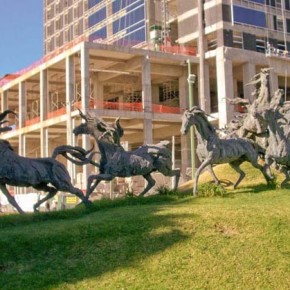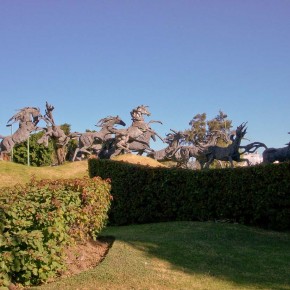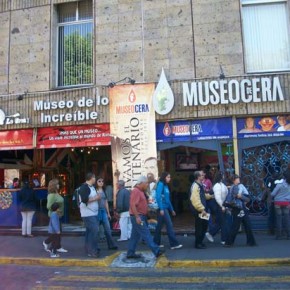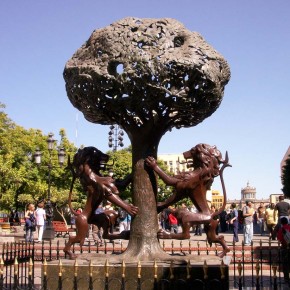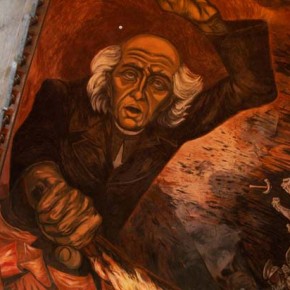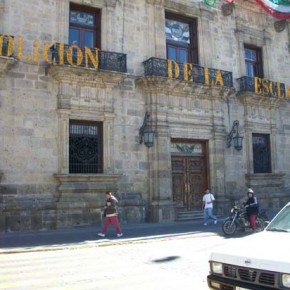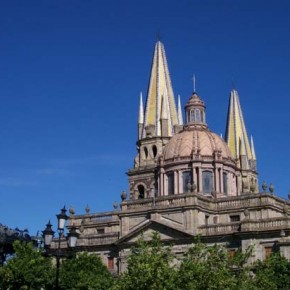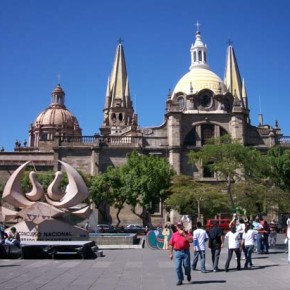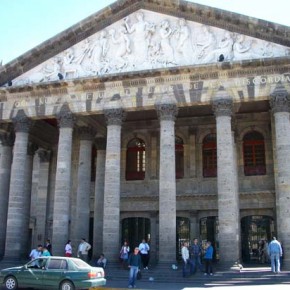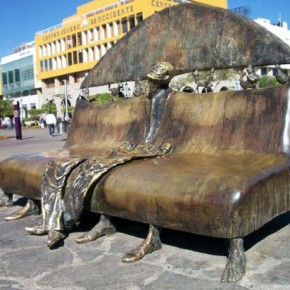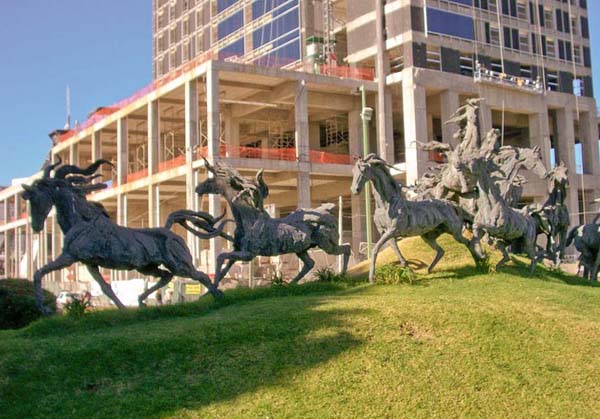
This bronze sculpture, called The Stampede, shows a lifelike, thundering herd of wild horses. It’s a focal point at the Glorieta de las Jicamas in Zapopan, an area sometimes nicknamed “Guadalajara’s Beverly Hills.” Photo by Nancy Seeley
The first time I visited Guadalajara, I was prepared to be completely overwhelmed. I’d been living in Zihuatanejo for awhile and was used to a small town atmosphere. Now I was going to a place about seventeen times bigger…actually fifty times mas grande if you include the seven adjacent municipalities comprising the densely-populated metropolitan area. We’re talking over 4 million people!
BUT: I was so intrigued I couldn’t NOT go. I wanted to see the birthplace of the world-renowned mariachi bands, the Mexican hat dance, the sombrero itself, cowboy-style rodeos (charreadas)…plus I’d be within stomping distance of the heart of tequila country. I wanted to check out colonial architecture situated cheek by jowl with soaring skyscrapers and intriguing modern designs. I wanted to cocoon myself in a cosmopolitan setting for a few days so returning to the tranquil pleasures of Zihuatanejo’s sun, sand and surf would be even more enticing than usual. So I went.
Arriving in the early morning after an eight-hour overnight bus ride from Zihuatanejo, my heart sank. Here I was in this humongous U-shaped bus terminal with eight separate modules – numbered 1 through 7 plus another tagged “1-1/2” stuck in there to confuse things – wondering how I’d get to the hotel room I’d booked in the centro histórico. Within minutes things started looking up. A few of the modules were equipped with individuals specifically looking for bewildered folks like me so they could provide information on taxis, buses, tourist attractions, hotels, restaurants, etc.
Minutes later I was comfortably seated in an air-conditioned Tur (tour) bus headed for the heart of the historic downtown area. The half-hour trip ended not far from Guadalajara’s most distinctive landmark, a cathedral nearly 400 years old topped with twin yellow spires rebuilt after an 1818 earthquake destroyed them. The cathedral, though awe-inspiring, does make one scratch one’s head wondering if its designers couldn’t make up their minds on what style to embrace, given the neoclassical, baroque and Churrigueresque influences on display.
There’s so much to see in Mexico’s second largest city it’s probably wise to confine an initial visit to the centro histórico (historic center) and leave the rest for another time. Even if you speak no Spanish and are directionally challenged, it’s hard to stay lost for very long. One very inviting place to explore is Plaza Tapatía, which stretches for seven blocks starting behind the cathedral and heading east. There’s a tourism office — local phone 33-3668-1600 — along the plaza featuring an English-speaking staff with a supply of maps to point you anywhere you feel like going. (FYI, the nickname for Guadalajara residents is Tapatíos.)
At one end of the pedestrian plaza is Teatro Degollado with its column-fronted exterior. Check out the red velvet and gold interior. If the Guadalajara Philharmonic’s not in town for a performance AND you’re not afraid of heights, get one of the cheap seats in the fifth tier balcony for the Ballet Folklorico on Sunday morning. A bit of history: Guadalajara actually existed in three prior locations before its present site was dedicated on February 14, 1542 with a ceremony right about where Teatro Degollado now stands.
Sauntering the entire length of Plaza Tapatía’s wide, well-kept walkway can be a time-consuming undertaking. People watching, alone provides nonstop entertainment. Vendors hawking their wares, street performers hoping for tips, and locals taking in the frenetic activity generally fill the available space during prime time. If you don’t want to bump elbows with fellow strollers, get an early start. You’ll encounter dozens of eateries, stores, crafts and commercial establishments like “Ripley’s Believe It or Not” and a wax museum.
Take a load off at one of the many benches scattered around the plaza and check out the creatively-designed gurgling fountains and unusual sculptures. I was particularly enchanted by Alejandro Colunga’s many bronze pieces depicting a magician transforming himself into either a sofa or a chair! Get a picture of yourself plunked down on one of these things for the scrapbook.
Anchoring the plaza at the other end is the Instituto Cultural de Cabañas, built in the early nineteenth century as an orphanage and home for invalids. Now the huge structure teems with culture that sometimes spills into the twenty-three courtyards via frequently changing exhibits. What doesn’t change are the fifty-seven murals painted by renowned artist José Clemente Orozco in the late 1930s. Orozco was a committed anti-fascist and used his skill to visually pontificate against the excesses of power.
Not long before you get to Cabañas, look off to your right and you’ll see the enormous Mercado Libertad, commonly called Mercado San Juan de Dios by the locals. It’s three stories tall and takes up two whole city blocks. Inside you can find everything from key chains to pig intestines, pirated DVDs to socks, hammers to party dresses, electrical adapters to silver jewelry, leather goods to boom boxes…well, the list goes on and on. It’s a feast for the eyes and an inexpensive place to shop. Your pesos go a long way here.
Plaza Tapatía is one of a quintet of plazas in Guadalajara’s historic center. On the south side of the cathedral is Plaza de Armas, featuring the Government Palace, which houses more of Orozco’s distinctive murals. Plaza Guadalajara is west of the cathedral and home to the Municipal Palace, which looks really old but celebrated its sixtieth birthday not long ago. Plaza de la Liberación claims the east side and is ringed by the Justice Palace, the Legislative Palace, and lots of room for throngs of students, starry-eyed lovers, business people on coffee breaks, and (occasionally) demonstrators. The small Plaza de los Martires (martyrs), on the southwest side, completes the array.
Though it’s not a plaza, the Rotonda de los Jaliscenses Ilustres north of the cathedral pays homage to twenty of Jalisco state’s favorite writers, composers, revolutionaries and architects. Until recently, the bronze statues were exclusively male. Thank goodness there’s now one woman in the group! Just east of here is Guadalajara’s regional museum boasting historical relics, an archaeological section, paintings, military displays, and more.
And all that’s just around the cathedral! There’s also Plaza de los Mariachis, a tad south of Mercado Libertad. It looks rather innocuous during the day, but it comes alive at night – so much so that a hotel room in this area of economical accommodations will virtually ensure you of musical entertainment until the wee hours of the morning.
Bring warm clothes for early morning and after sunset hours, and keep in mind the 5,000-ft. altitude and higher pollution levels will have you huffing and puffing more than Zihuatanejo’s clean sea level air.
When you’re ready to venture further a field, there are parks, temples, a university area, a zoo, craftsy areas like Tonalá and Tlaquepaque, a stadium featuring soccer games and other sporting events, rodeos, bullfights, upscale shopping areas like Zapopan, numerous water parks and natural hot springs and more to explore. Guadalajara’s huge array of buses provide frequent transport to places like Tequila, the Lake Chapala communities, and mountainous regions just hours away by road but decades behind in terms of modernity. It’s almost a guarantee your first visit to the home of the Tapatíos will not be your last.
- This bronze sculpture, called The Stampede, shows a lifelike, thundering herd of wild horses. It’s a focal point at the Glorieta de las Jicamas in Zapopan, an area sometimes nicknamed “Guadalajara’s Beverly Hills.” Photo by Nancy Seeley
- This bronze sculpture, called “The Stampede,” shows a lifelike, thundering herd of wild horses. It’s a focal point at the Glorieta de las Jicamas in Zapopan, an area sometimes nicknamed “Guadalajara’s Beverly Hills.” Photo by Nancy Seeley
- Yup! There they are! The Museo de lo Increible (Ripley’s Believe It or Not) and Guadalajara’s Museo de Cera (Wax Museum) — also on lengthy Plaza Tapatía. Photo by Nancy Seeley
- This sculpture, situated along Plaza Tapatía, depicts “Two Lions and a Tree,” which is Guadalajara’s coat of arms. Photo by Nancy Seeley
- Inside the Government Palace, a powerful Orozco mural shows Father Hidalgo carrying a fiery torch and figuratively breaking the bonds of slavery during the 1810 Mexican Revolution. To see it, go in the main entry door, turn right at the staircase. Photo by Nancey Seeley
- The Palacio de Gobierno is well known as the place where Father Miguel Hidalgo abolished slavery in Mexico on Dec. 6, 1810. Photo by Nancy Seeley
- Guadalajara’s impressive cathedral suffered damage during six earthquakes between1932 and 2003. As a result, the north tower tilts slightly, and there’s structural deterioration affecting the dome. Photo by Nancy Seeley
- No matter what angle you use to shoot photos of Guadalajara’s cathedral at street level, there’s bound to be trees, sculptures and people in your viewfinder. Photo by Nancy Seeley
- It took 30 years to build Teatro Degollado in the mid-19th century. The frieze you see above the columns shows Apollo and the Nine Muses. Photo by Nancy Seeley
- Here’s one of those whimsical Alejandro Colunga bronze sculptures near Instituto Cultural de Cabañas. If you don’t fancy sitting down in this one, there are several others to choose from nearby. Photo by Nancy Seeley

